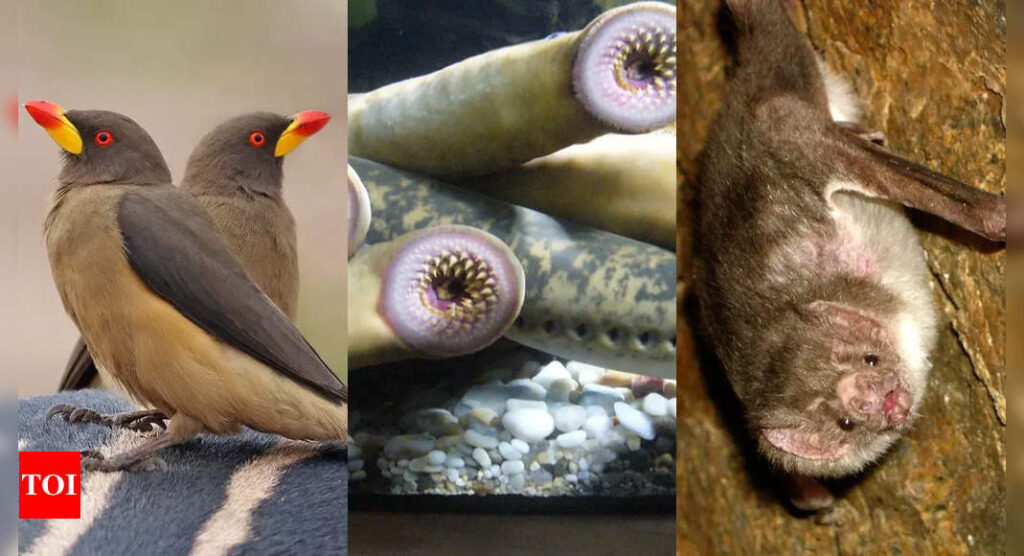Discover 8 animals that suck blood for survival |

You’ve likely heard stories of insects sucking blood, but did you know some animals do it too? Known as hematophagous creatures, these animals depend on blood for survival. Familiar examples include vampire bats, vampire moths, the vampire ground-finch, and even the oxpecker bird.
Blood is a nutrient-rich fluid, providing essential proteins, iron, and other nutrients to fuel these animals.In some cases, hematophagy evolved due to food scarcity, as blood offers a vital substitute. These animals possess specialised traits—like sharp teeth, claws, or beaks—to extract blood from their hosts.
While insects like mosquitoes and ticks are common bloodsuckers, these animals also play a fascinating role in nature’s survival strategies. Explore these eight incredible creatures that feed on blood.
Why do animals suck on blood?
Animals suck on blood for various reasons, mainly all-related to survival:
Nutrient-rich source
Blood is a highly nutritious fluid, rich in proteins, iron, and other vital nutrients. By consuming blood, these animals can access a concentrated source of essential nutrients needed for their growth, reproduction, and survival. For example, vampire bats can sustain themselves by feeding exclusively on blood, which provides the necessary energy for their activities.
Adaptation to resource scarcity
In some cases, blood-feeding evolved as a response to environmental challenges, such as food scarcity. For instance, the vampire ground-finch in the Galápagos Islands may have started feeding on blood when other food sources like seeds or insects were unavailable. Blood serves as a substitute source of hydration and sustenance, especially in dry or resource-poor environments.
Specialised feeding behaviour
Many blood-feeding animals have evolved specialised physical traits to access blood efficiently. The sea lamprey has a sucker-like mouth with sharp teeth, allowing it to latch onto and extract blood from larger animals. Similarly, vampire moths use their specially adapted mouthparts to pierce the skin of their hosts.
Parasitic strategy
Some animals, like the candiru fish, adopt parasitic strategies. They exploit larger hosts by feeding on their blood, benefiting from the host’s body as a constant and reliable food source. This parasitic relationship allows the candiru to extract blood without needing to hunt or scavenge for food.
Evolutionary adaptation
The evolution of blood-sucking behaviour is often driven by natural selection, where hematophagy provides a survival advantage. In the case of vampire bats, feeding on blood is a highly specialised niche that reduces competition for other food sources. Additionally, some species have developed mechanisms to ensure efficient feeding, such as the anticoagulant in vampire bat saliva that keeps blood flowing during feeding.
Blood-sucking animals
Vampire bats
While only one subfamily of bats, Desmodontinae, drinks blood, these “vampire” bats are well-known. They locate mammals or birds by detecting breathing, then use heat sensors to find blood vessels near the skin. A single feeding can double a bat’s body weight. Interestingly, the saliva of Desmodus rotundus, the species that feeds on humans, contains an anticoagulant used in stroke treatment.
Oxpecker
Native to Sub-Saharan Africa, the oxpecker bird feeds on both parasites and blood. They often peck at wounds on cattle, drinking the blood and sometimes worsening the injury, which can lead to infections.
Candiru fish
The infamous candiru, a parasitic catfish from the Amazon, has a disturbing reputation for entering human orifices, though this may be exaggerated. Typically, it swims into the gills of other fish to suck blood from their arteries, riding its host for miles while feeding.
Sea lamprey
Sea lampreys use their suction-cup mouths, lined with teeth and a rasping tongue, to latch onto fish and marine mammals, feeding on their blood. They are migratory creatures, often travelling between rivers and oceans.
Vampire moth
Originally fruit-eaters, vampire moths have evolved to feed on human blood. Using their hook-lined mouths, they pierce the skin and drink, providing a glimpse into the evolution of bloodsucking insects.
Vampire ground-finch
Endemic to the Galápagos Islands, this finch typically feeds on seeds and insects but resorts to blood when resources are scarce. It pecks at the blood vessels of seabirds to drink, likely a behaviour that evolved from feeding on the parasites of these birds.
Leeches
Leeches are well-known bloodsuckers, commonly found in freshwater environments. They attach to their hosts using suckers and secrete anticoagulants to keep the blood flowing while they feed. Medical leeches are even used in modern medicine to aid in blood circulation after surgeries.
Lice
Lice are parasitic insects that specialise in feeding on the blood of specific animals and even particular parts of their host’s body. They have piercing mouthparts that allow them to attach and suck blood from their chosen area. On humans, for example, head lice feed on blood from the scalp, while body lice tend to bite around the seams of clothing. Each species of lice is highly adapted to its environment, making them effective and persistent parasites.
Also read: 7 Animals that transform to white for survival during winters








